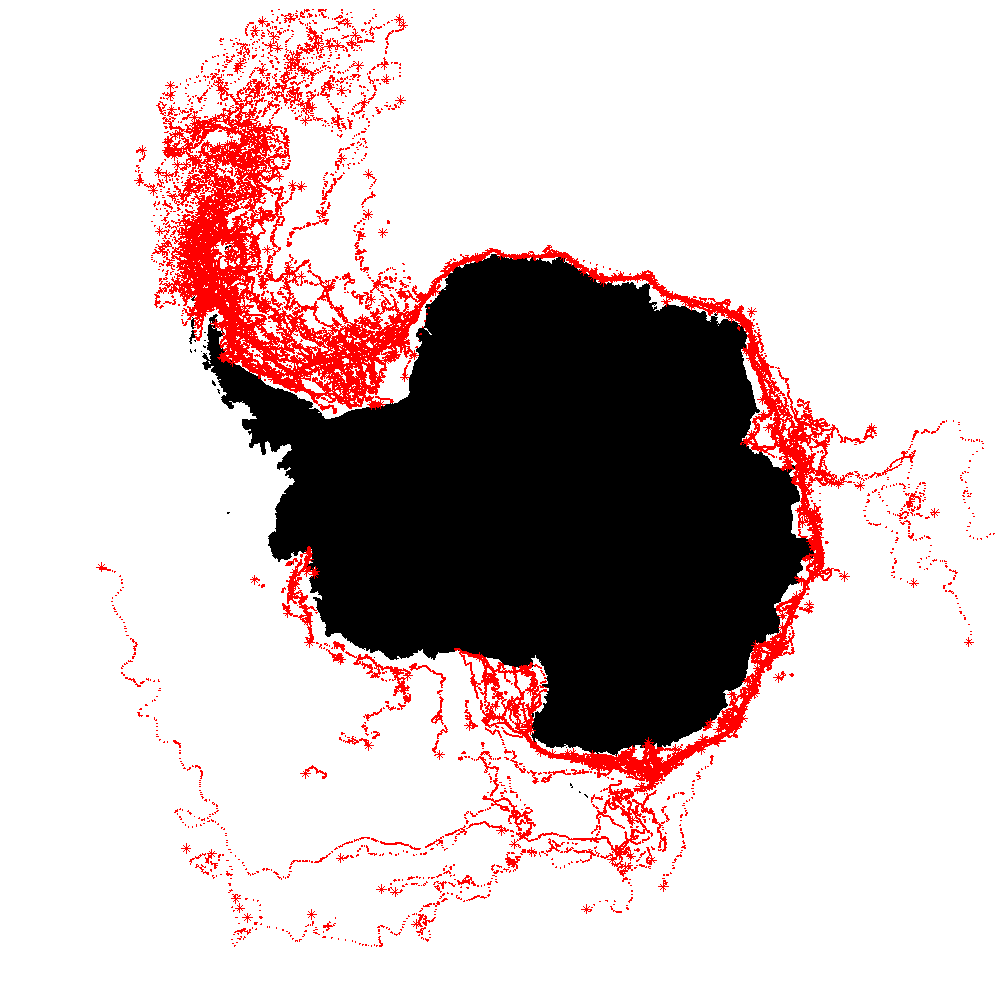Icebergs can be found floating freely in the ocean around the Antarctic and Greenland ice sheets, as well as in other areas with glaciers that end in the ocean. They can be important for the survival of many animals, such as polar bears in the Arctic or penguins in the Antarctic, but they can also pose danger to ships sailing in the polar regions. In 1912, an iceberg led to the sinking of the RMS Titanic in the North Atlantic Ocean.

Iceberg A68 broke off from the Larsen C Ice Shelf in 2017. When it started drifting towards the sub-Antarctic islands of South Georgia, there was widespread concern as large icebergs can become stuck (or ‘grounded’) on the continental shelf, causing issues for local breeding wildlife like seals and penguins. Fortunately, the iceberg broke up and drifted away without causing too much harm.
What are icebergs?
An iceberg is a piece of freshwater ice that has detached from a glacier and is floating in the ocean (Figure 1). Icebergs form when pieces of ice break off the end of an ice shelf or a glacier that flows into a body of water (Figure 2). This is called “calving” and it’s a natural process that is responsible for ice loss at the edges of glaciers and ice sheets (1).
Large icebergs can also calve and break apart into multiple smaller icebergs, and ice shelves have been known to rapidly collapse and disintegrate into several or even thousands of icebergs (2, 3).

In Antarctica, icebergs will calve off the marine-terminating glaciers and then float away (Figure 3). They will drift with the ocean currents. In the winter, they may become frozen into the sea ice. Eventually, they will melt away completely. The image below shows iceberg tracks, measured by satellite imagery, from 1999-2010.

How large are icebergs?
Icebergs range in size from small “growlers,” to medium or large “bergy bits,” all the way up to true “icebergs” (Figure 4, 5). Growlers are the smallest, reaching lengths up to 2 m (4) whereas bergy bits have lengths between 2 and 5 m (5). Anything larger than a bergy bit is considered an iceberg, and they can be several thousand square kilometers in area. Brash ice is a mixture of free floating ice of less than 2 m across. A group of icebergs is often called a flotilla or armada, and smaller groups may be called a fleet, cluster, drift or litter. A mixture of frozen sea ice, bergy bits, icebergs and brash ice at the margin of a calving glacier in a fjord is called an ice melange. This ice melange can provide some backstress, supporting the glacier margin.

The largest iceberg observed by satellite was Iceberg B-15, which calved from Antarctica’s Ross Ice Shelf in 2000 and was larger than the island of Jamaica (6).

How do icebergs float?
Icebergs are made up of frozen freshwater, which is less dense than the liquid saltwater in the ocean. This causes icebergs to float in water. However, since the density of ice is about 90% the density of water, most of an iceberg’s mass is below the surface while only about 10% sticks out of the water. When you see an iceberg floating, you’re really only seeing a small portion of it since most of it is hidden below the surface.
As the icebergs melt, they change their position and rise up in the water column, often leading to beautiful shapes and patterns (Figures 4, 6).

The orientation of a floating iceberg is dependent on where its center of gravity and buoyancy are relative to one another (7). Generally, icebergs will float so their long axis is parallel to the ocean surface (Figure 5).
When an iceberg begins to melt, its changing shape can cause the centers of buoyancy and gravity to shift, which might make the iceberg unstable enough to capsize or “topple” (7, 8) . Icebergs can also topple immediately after calving if they are not initially in a stable orientation to float, and this process can release energy (Figure 6). In fact, it has been suggested that energy released from thousands of capsizing icebergs may have helped to drive the rapid collapse of the Larsen B Ice Shelf in 2002 (2, 3, 9).
For this reason, it’s a good idea to always keep your distance from large icebergs!

Draw your own iceberg and see how it floats using the Iceberger tool:
https://joshdata.me/iceberger.html
About the author
Megan Thompson-Munson is an Atmospheric and Oceanic Sciences PhD student at the University of Colorado Boulder where she studies interactions between ice sheets and the climate. She is particularly interested in better understanding firn processes in both Greenland and Antarctica.
Megan graduated with her MS degree in Geology from the University of Wyoming in 2020. Her MS work focused on Greenland Ice Sheet dynamics and involved two field seasons on the ice sheet. Field work brought her to the town of Ilulissat, Greenland where she first saw icebergs and was instantly fascinated by them. Megan earned dual BS degrees in Geology and Environmental Science in 2017 from the University of Massachusetts Amherst where she completed an honors thesis on biogeochemical reconstructions of East African paleoclimates.

